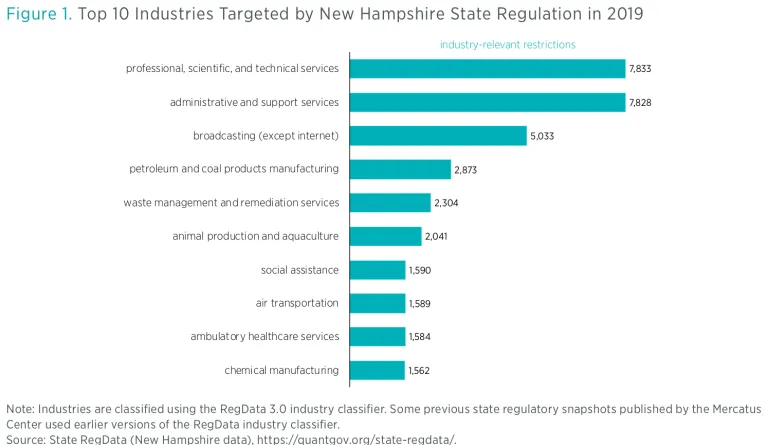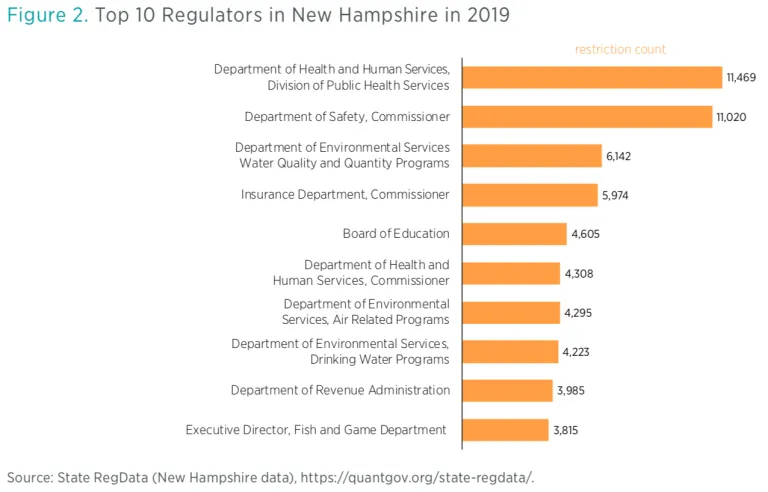- | Regulation Regulation
- | Policy Briefs Policy Briefs
- |
A Snapshot of New Hampshire Regulation in 2019
123,423 Restrictions, 7.3 Million Words, and 10 Weeks to Read
It would take an ordinary person more than two and a half years to read the entire US Code of Federal Regulations (CFR), which contained nearly 104 million words in 2017. The sheer size of the CFR poses a problem not just for the individuals and businesses that want to stay in compliance with the law but also for anyone interested in understanding the consequences of this massive system of rules. States also have sizable regulatory codes, which add an additional layer to the large body of federal regulation. A prime example is the online version of the 2019 New Hampshire Code of Administrative Rules (NHCAR).
Researchers at the Mercatus Center at George Mason University developed State RegData, a platform for analyzing and quantifying state regulatory text. State RegData captures information in minutes that would take hours, weeks, or even years to obtain by reading and counting. For example, the tool allows researchers to identify the industries that state regulation targets most by connecting text relevant to those industries with restrictive word counts. These regulatory restrictions, represented by the words and phrases shall, must, may not, prohibited, and required, can signify legal constraints and obligations. As shown in figure 1, the three industries with the highest estimates of industry-relevant restrictions in the 2019 NHCAR are professional, scientific, and technical services (which includes legal services, accounting and tax preparation, and a variety of other professional services); administrative and support services; and broadcasting (except internet).
State RegData also reveals that the 2019 NHCAR contains 123,423 restrictions and 7.3 million words. It would take an individual about 403 hours—or more than 10 weeks—to read the entire NHCAR. That’s assuming the reader spends 40 hours per week reading and reads at a rate of 300 words per minute. By comparison, there are 1.09 million additional restrictions in the federal code. Individuals and businesses in New Hampshire must navigate these different layers of restrictions to remain in compliance.

The titles and subtitles in the NHCAR are organized by agency and subagency. Figure 2 shows that the title of the NHCAR associated with the Department of Health and Human Services, Division of Public Health Services contains 11,469 restrictions. By this measure, this is the biggest regulator in New Hampshire. Coming in second is the commissioner’s office within the Department of Safety, with 11,020 restrictions.

Federal regulation tends to attract the most headlines, but it is important to remember that the nearly 104 million words and 1.09 million restrictions in the federal code significantly understate the true scope of regulation in the United States. States like New Hampshire write millions of additional words of regulation and hundreds of thousands of additional restrictions. State-level requirements carry the force of law to restrict individuals and businesses just as federal ones do.
Researchers are only beginning to understand the consequences of the massive and growing federal regulatory system on economic growth and well-being in the United States. Meanwhile, the effects of state regulation remain largely unknown. If this snapshot of New Hampshire regulation in 2019 is a good indicator, then the states are also active regulators, suggesting that the full impact of regulation on society is far greater than that of federal regulation alone.
Acknowledgment
The author would like to thank Michael Kotrous for helpful research and programming assistance that contributed to this report.

